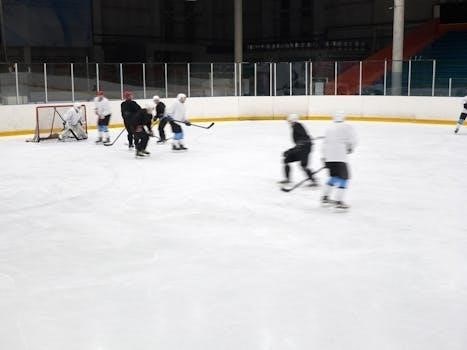Youth speed and agility training is crucial for developing well-rounded athletic abilities. These programs focus on enhancing the ability to move quickly and change direction efficiently. It’s important for sports participation and overall fitness.
Importance of Speed and Agility in Youth Athletics
Speed and agility are fundamental components of athletic success for young athletes. These abilities are not just about running fast; they encompass the capacity to change direction quickly and maintain balance, crucial in various sports; Enhanced speed allows young athletes to outpace opponents, while agility provides the advantage of evading challenges and making swift, decisive moves. Developing these skills early not only elevates performance but also reduces the risk of injuries by improving coordination and body control. Incorporating speed and agility training in youth athletics programs creates well-rounded athletes who are prepared for the demands of competitive sports and promotes overall physical fitness from a young age. It contributes to enhanced athleticism, increased confidence, and a foundation for lifelong physical activity.

Key Components of a Youth Speed and Agility Program
A comprehensive youth program includes straight-line speed drills, change of direction exercises, and footwork coordination. These elements improve overall athletic performance and reduce injury risks for young athletes.
Straight Line Speed Development Drills
Straight-line speed development focuses on improving an athlete’s ability to run quickly in a linear direction. These drills often involve sprints of varying distances, such as 40-yard dashes and 100-yard runs, with a focus on proper form and technique. Acceleration drills are essential, emphasizing the initial burst of speed from a stationary position. Coaches should observe for common errors that inhibit speed and focus on drills to improve strength and power for better time over short distances. Drills should include a high knee action, forceful arm movements, and maintaining a forward body lean during acceleration and getting tall during the run.
Change of Direction and Agility Drills
Change of direction and agility drills are crucial for athletes needing to quickly alter their movement patterns. These exercises focus on improving the ability to change direction without losing balance or speed. Drills include lateral hops over objects, zigzag hops, and shuffles, which enhance the athlete’s ability to move efficiently sideways. Box cone drills and partner mirror drills are also beneficial for improving reaction time and agility. Staying on the balls of the feet and maintaining a low hip position are key coaching points. These drills combine speed, strength, balance, and coordination, making them a vital part of any youth training program. The aim is to improve the athlete’s quickness and control in dynamic situations.
Footwork and Coordination Exercises
Footwork and coordination exercises are fundamental for developing agility and overall athletic performance. These exercises aim to improve the athlete’s ability to control their body movements with precision. Drills such as heel-toe walks, reach and rock and roll, and backward monster walks with mini bands help build stability and coordination. Ladder drills are also essential, focusing on quick foot movements and high knees. Continuous side shuffles with hip turns enhance lateral movement and coordination. These exercises are designed to improve balance, which is key for change of direction drills. Proper footwork and coordination are crucial for executing complex movements with speed and accuracy, leading to better athletic performance.

Implementing a Training Program
Effective implementation involves proper warm-up protocols, incorporating speed and agility. A structured schedule and progressive exercises are needed. This ensures safe and effective athletic development for youth athletes.
Warm-up Protocols Incorporating Speed and Agility
Integrating speed and agility work into warm-up routines is an efficient strategy. These protocols should prepare young athletes for more intense training. A dynamic warm-up is essential, including movements that mimic the activities planned for the session, such as high knees, butt kicks, and lateral shuffles. Focus on light cardio to increase heart rate and muscle activation. Followed by dynamic stretches to improve range of motion, prepare muscles and joints. Incorporate elements such as skipping, hopping, and gentle changes of direction to prime the nervous system. This combination is a time-efficient way to deploy speed and agility training and reduces the risk of injury. This ensures that the body is adequately prepared for the demands of the training session ahead.
Sample Training Schedule and Progression
A well-structured training schedule is vital for effective speed and agility development in youth athletes. A program should start with basic drills and gradually increase in intensity and complexity over time. For example, the first week may focus on straight-line speed and basic footwork exercises. Progression could involve introducing change of direction drills in week two, and more complex agility patterns in week three. The program should incorporate rest and recovery periods to avoid overtraining. It is necessary to monitor each athlete’s progress. And adjust the schedule based on individual needs. A sample schedule may include 2 to 3 speed and agility sessions per week, with each session lasting for a reasonable period.

Specific Drills and Techniques
This section explores various drills and techniques to enhance speed and agility, including ladder drills for footwork, cone drills for direction changes, and hurdle drills to improve agility. Each drill targets specific skills.
Ladder Drills for Agility and Footwork
Ladder drills are fundamental for developing agility and precise footwork in young athletes. These drills involve quick, coordinated movements through the rungs of an agility ladder, enhancing speed and accuracy. Exercises like single foot hops, high knees, and lateral shuffles are common. These drills improve the athlete’s ability to react quickly and maintain balance while moving rapidly. Furthermore, consistent ladder training promotes better coordination and rhythm, crucial for various sports. The drills focus on staying on the balls of the feet and keeping hips low for better agility. Mastering these drills enhances the athlete’s overall movement efficiency and agility and helps in injury prevention.
Cone Drills for Change of Direction
Cone drills are essential for developing change of direction skills in youth athletes. These drills use cones to create a variety of paths, which helps in improving agility and quickness. Athletes perform movements such as shuttles, zig-zags, and figure eights around the cones. These drills enhance the ability to rapidly change direction while maintaining balance and speed. Proper technique, like staying low and using quick footwork, is emphasized. Cone drills are designed to improve an athlete’s ability to react, pivot, and accelerate efficiently in different directions. They are valuable for developing sport-specific agility and are adaptable for various skill levels. Regular practice with cone drills significantly enhances an athlete’s overall agility and performance.
Hurdle Drills for Agility
Hurdle drills are a valuable component of agility training for young athletes. These drills use low hurdles to enhance coordination, foot speed, and the ability to change direction quickly. Athletes perform various movements over and around the hurdles, such as lateral hops, shuffles, and quick steps. These exercises improve the athlete’s ability to react rapidly and maintain balance while navigating obstacles. Proper form and technique are crucial, focusing on staying on the balls of the feet and keeping the hips low. Hurdle drills not only increase agility but also enhance body awareness and control. They are adaptable to different skill levels and can be modified to suit individual needs. Regular practice with hurdle drills will enhance overall agility and athletic performance.

Advanced Training Considerations
Advanced training involves integrating strength work with speed exercises, focusing on proper technique, and monitoring progress. Adjustments are necessary to optimize training for peak performance. Always prioritize safety.
Integrating Strength Training with Speed Work
Combining strength training with speed work is essential for maximizing athletic performance in young athletes. Strength provides the foundation for generating power, which is crucial for both speed and agility. Incorporating exercises that build lower body strength, like squats and lunges, directly translates to increased running speed and explosive movements. Furthermore, core strength plays a significant role in stability and force transfer during agility drills. A well-structured program should balance strength exercises with speed and agility drills, ensuring that young athletes develop both power and the ability to efficiently utilize it. This holistic approach not only enhances performance but also reduces the risk of injury. Focusing on proper technique during both strength and speed workouts is paramount for optimal results.
Importance of Proper Technique and Form
Proper technique and form are paramount in youth speed and agility training. Focusing on correct movement patterns ensures that athletes develop efficient and effective movement skills. Poor form not only hinders performance but also significantly increases the risk of injuries. For example, improper running mechanics can lead to knee and ankle problems. Similarly, incorrect landing techniques during agility drills can cause strains and sprains. Emphasizing proper body alignment, foot placement, and arm movements from the start is crucial; Coaches should prioritize teaching and reinforcing correct technique over increasing speed or intensity too quickly. This foundational approach leads to long-term athletic development and reduces the likelihood of overuse injuries. Mastering the fundamentals of movement enables athletes to maximize their potential while minimizing risk.
Measuring Progress and Adjusting the Program
Regularly measuring progress is essential for an effective youth speed and agility program. It allows coaches to track improvement and make necessary adjustments. Timed drills, such as the 40-yard dash or shuttle runs, provide quantifiable data on speed and agility gains. Performance in agility drills, like cone drills or ladder exercises, should be monitored to assess change of direction ability. Observing movement patterns and technique can reveal areas for refinement. Based on this data, coaches can modify the training program to meet individual needs. If an athlete struggles with a particular exercise, adjustments to complexity or intensity may be required. Conversely, if an athlete is excelling, the program may need to be advanced to continue progress. This data-driven approach is crucial for optimizing training and ensuring continued development. Consistent assessment leads to a more personalized and effective program.
